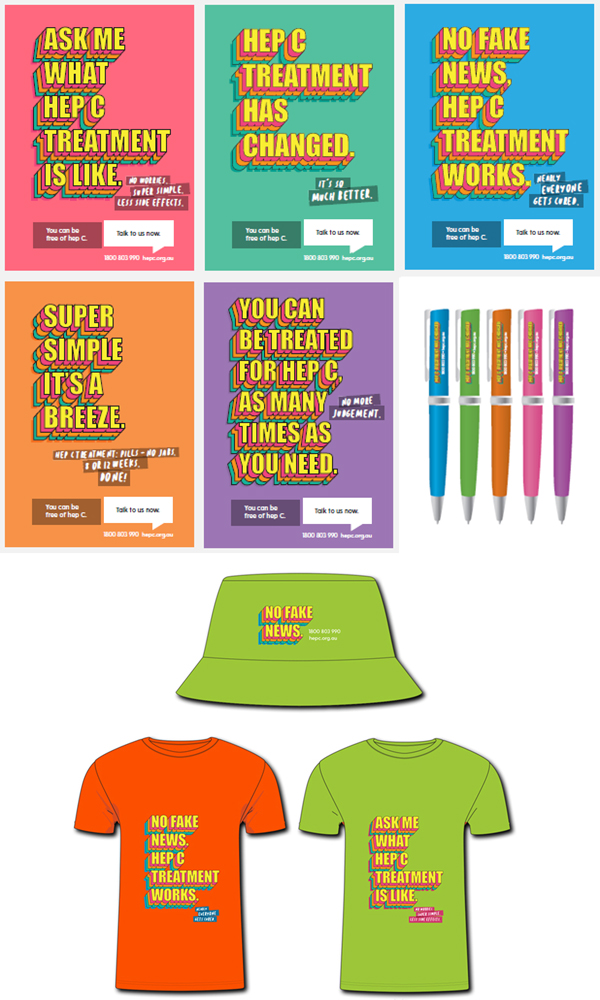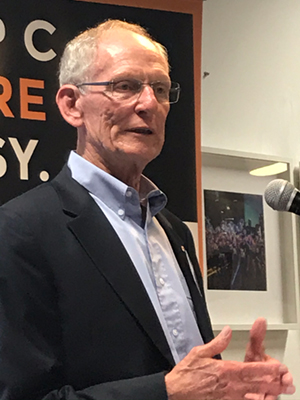The Champion #80 – January 2020
This issue:
- Clearing The Path from this January
- Audrey Lamb Community Forum 2019
- Hepatitis NSW’s commitment to environmental responsibility

Clearing The Path from this January
Starting January and running throughout February, Hepatitis NSW – in partnership with NUAA – is rolling out Clearing the Path, an exciting mini-campaign. The campaign is designed for people who inject drugs – to reinvigorate interest in hep C treatment and cure. Clearing the Path is a precursor to our major 2020 campaign.
Clearing the Path is based on audience research conducted in 2019 with people who inject drugs and will help to:
- debunk myths about treatment identified in the research;
- address these beliefs free of stigma and discrimination;
- encourage reassessment of existing assumptions about treatment; and
- prompt renewed/new consideration of hep C treatment as a possibility for them.
The messaging is drawn from a NUAA resource addressing myths and misinformation about direct acting antiviral treatments. The campaign aims to address the barriers and motivators identified by people who inject drugs through audience research.
Clearing the Path consists of a suite of five eye-catching posters in uplifting, positive colours with easy read text that stands out in health service and public settings. The call-to-action is “Talk to us now”, to start conversations with peers or staff. Contact details are given for the Hepatitis Infoline – 1800 803 990 – and campaign website – hepC.org.au
The campaign will only appear within, or close to, one or two high turnover NSPs in each Local Health District (LHD) where people who inject drugs visit. The exciting and unique component of the campaign is that it will be promoted by NUAA and Hepatitis NSW peer staff, who will be attending the selected NSPs and starting conversations about treatment of hepatitis C for the community.
Collateral being produced includes:
- posters inside the NSP, and on outdoor street and pole posters in the vicinity;
- toilet door convenience advertising in selected local venues;
- pavement stencils; and
- T-shirts for peers and staff.
Peers will engage in conversations about hep C treatment and give out merchandise:
- postcards; and
- water bottles, hats, pens, and lanyards.
The peer promotion will occur within the program models based on Peer Link (NUAA) and Live Hep C Free (Hepatitis NSW).
Clearing The Path goes live from January 13. We will have further news, information and pics from the campaign in the next two editions of The Champion.
Audrey Lamb Community Forum 2019
The Audrey Lamb Community Form is an annual event that features a guest address delivered at the Hepatitis NSW Annual General Meeting. At this year’s forum, Dr Bob Batey, Senior Staff Specialist Physician in the Department of Medicine at Alice Springs Hospital, spoke on the complexity of hep B. Here is an edited excerpt from his address, given in November last year.

I was working as a clinician when both hepatitis B and hepatitis C were first identified. I now work in Central Australia, facing the challenges of this remote part of the world. My first trips to Alice Springs, 13 years back, were purely to provide hepatitis C treatment in Central Australia. As that treatment has now become increasingly effective, hepatitis B has become a focus for me.
Both viruses are incredibly complex and that complexity affects every level of the interaction between virus and human. From the virology to the disease, and on to the sociology of viral hepatitis.
The complexity of hepatitis B
The hepatitis B virus was discovered long before that of hepatitis C, but its complexity is only now being fully appreciated. It is a DNA virus that can get bits of itself into our own DNA or genome. We have had an effective vaccine for hepatitis B since the 1980s, but the disease is not controlled yet and there are currently no curative drugs.
Hepatitis B tells us stories of the migration of humankind across the globe millennia ago. The work on the hepatitis B C4 genotype that affects Aboriginal people, and very few other people in the world, is fascinating and ongoing. The interaction between hepatitis B and other viruses, such as the human T-lymphotropic 1 virus, is something that is also demanding attention in Central Australia where the natural history of hepatitis B is different from that seen in other parts of the world.
Hepatitis B has maintained its place in communities because of mother-to-child transmission. The effective use of vaccine and immunoglobulin for babies born to hep B positive mothers, and the use of antivirals in women with high viral loads, has reduced mother-to-child transmission dramatically. Sadly, the complexity of the virus, and the fear of the virus, leads to two quite opposite and opposing responses.
On one hand there are health care workers resisting the use of vaccine for babies born to hep B positive mothers, and they make a point of delaying immunoglobulin despite evidence that the earlier it is given under 24 hours, the better the effect. This is seriously worrying. Conversely, some practitioners recommend treating every pregnant woman with an antiviral, just in case transmission is possible. This seems to be not cost effective, but will relevant studies be done to find the right level for concern?
Both responses are based on an incomplete understanding of the complexity of hepatitis B and we must do better.
The hepatitis B virus was discovered before PCR technologies, and testing for it confuses clinicians. I get many calls per month asking what an isolated HBcAb result means (not “HBcAg“, as many doctors think it is!!); and when I try to explain it I can hear the doctor switch off halfway through the answer!
Central Australia confronts me with the fact that many patients who could be on hepatitis B drugs are not. It also confronts one with the fact that the effective vaccination program to protect babies from hepatitis B, introduced for Indigenous babies in the Northern Territory before any other part of the country, does not provide lifelong protection for everyone.
Hepatitis B is complex, but hopefully soon to be curable; the question is, would all those who need the drugs receive them?
We are still better advised to improve the uptake of hepatitis B vaccination to prevent spread of this disease. This is the most cost effective way to deal with this complicated virus.
Moving forward
Both hepatitis B and hepatitis C confront us with the complexity of working with people who are stigmatised by the general community. Aboriginal people, people who inject drugs, unemployed people – many are tagged with all three stigmatising labels, and yet they have diseases that could kill them.
Both these viruses have challenged those wanting to think seriously about managing these epidemics on a world-wide scale. How do you use medications optimally and safely? How do you ensure effective vaccination programs when some countries won’t add it to their schedules? How do you get access to expensive drugs for countries whose budgets simply cannot extend to the cost of them? How do you care for people who have multiple other issues making life awful, and for whom the virus is not their most pressing problem?
The good news is that while we still have a way to go to get everything in order and optimal care delivered everywhere there are people with hepatitis B or hepatitis C, we have made massive progress and not just at a laboratory level.
I think Audrey would be pleased with what she sees today but she would challenge us to not relax and to keep up the good work.
Hepatitis NSW’s commitment to environmental responsibility

The bushfires raging throughout NSW, and across Australia, for over ten weeks have brought into sharp focus and discussion the challenges of climate change and the need for responsible environmental action. The evidence is clear. Our weather has become more extreme and our climate has changed, significantly impacting our lives.
Generally, those people who are the worst affected by this, and similar, climate disasters are from communities already experiencing social and economic disadvantage. Climate change, extreme weather events, and the resulting environmental catastrophes, exacerbates these inequalities. People with inadequate housing, people with already existing health conditions, and people with poor access to health services are among those most disproportionately burdened by this new, unprecedented, environmental reality.
Hepatitis NSW is committed to environmental responsibility and reducing the impact of climate change. By reducing our emissions and waste, and our dependence on fossil fuels, we are improving sustainability and shrinking our carbon footprint. Practical measures we take include reducing paper wastage, recycling, using public transport and ride sharing. Our staff are also actively supporting the bushfire relief efforts!
Staff member Alex Ryan has been a volunteer with the State Emergency Services (SES) for four years and, in January, is working with the Bushfire Information Line coordinated by the NSW Rural Fire Service (RFS). Members from NSW SES are continuing to support the RFS and NSW Police Force by staffing public information phone lines, as well as on the ground with door knocking and several logistical support roles. Alex is also currently looking to be deployed to assist the RFS in other areas of the State.
With no sign of the fires abating and extreme weather events becoming more commonplace, Hepatitis NSW will continue to actively seek opportunities for our organisation to do our bit to regenerate the environment and address climate change.








